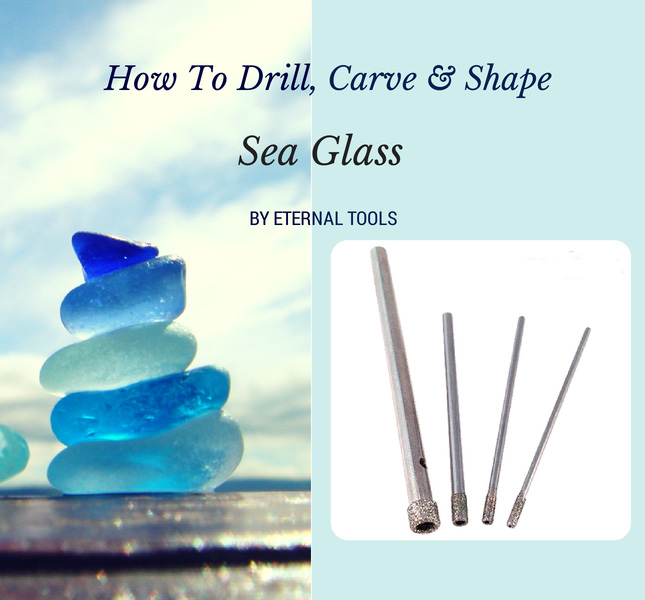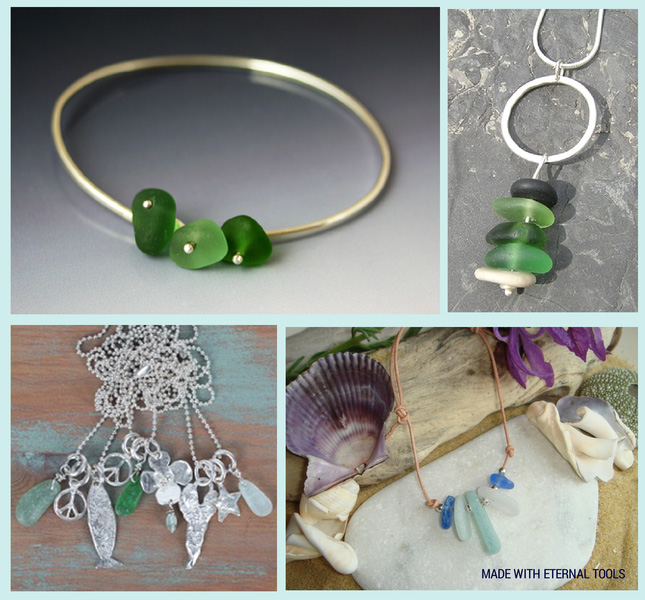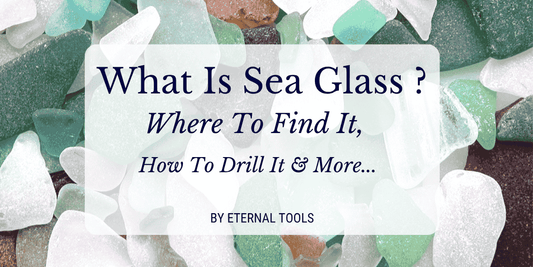What is Sea Glass? How It’s Formed, Where to Find It & How to Drill It
What is Sea Glass?
Sea glass is weathered glass that has been naturally tumbled and smoothed by the action of the sea. Originally discarded as waste, think bottles, jars, or even shipwreck remnants, these fragments are transformed over time by waves, salt water, and sand into small, frosted gems. They wash up along beaches, shaped and softened by years of movement in the ocean.
Sea glass and beach glass differ in origin and appearance. True sea glass is formed in saltwater and has a distinctive frosted, etched surface caused by the pH and chemical composition of the sea. Its edges are smooth and rounded, making each piece a unique product of time, tide, and geography.
For collectors, artists and beachcombers alike, sea glass holds a timeless appeal, a small piece of history, polished by nature.
How is Sea Glass Formed?
Sea glass begins life as ordinary glass, often bottles, jars, tableware or even shipwreck debris that has found its way into the sea. Over time, these discarded pieces are broken down by wave action, abrasion against sand and rocks, and long exposure to saltwater.
This natural tumbling process, combined with the high pH and chemical composition of seawater, gradually removes any sharp edges and gives the glass its distinctive frosted appearance. It can take between 20 and 100 years for a piece of glass to become what collectors recognise as genuine sea glass.
The longer the glass spends in the ocean, the more refined and weathered it becomes. Authentic sea glass will show pitting, a consistent matte surface, and rounded contours that indicate decades of natural erosion.
What’s the Difference Between Sea Glass and Beach Glass?
Although often used interchangeably, sea glass and beach glass differ in how and where they are formed. Sea glass is shaped by saltwater environments, coastlines, tidal zones, and open seas, while beach glass typically originates from freshwater lakes or rivers.
The key difference lies in texture and appearance. Sea glass is usually more frosted and heavily weathered due to the chemical effects of saltwater. Beach glass, on the other hand, often appears shinier and may have less-rounded edges because freshwater lacks the same level of abrasion and acidity found in oceans.
For example, the Great Lakes in North America are well-known for beach glass, whereas coastal locations like Seaham in the UK produce highly prized sea glass due to their saltwater exposure and industrial history.
For a more detailed look at this location, read our full guide to finding sea glass in Seaham.
Contrary to expectation, such beautiful pieces of sea glass and glass shards originally start life as discarded items, perhaps, a glass bottle tossed away without thought in the early 1900s, now reappears as a precious relic. Other such items are:
- Ex-drink bottles
- Glass items from windows
- Glasses
- Beer Bottles
- Wine bottles
- Glass Fishing Floats
Sea Glass Colours: Common and Rare
Sea glass comes in a wide range of colours, depending on its original source. While some colours are common and easy to find, others are considered rare and highly collectible. Each hue tells a story of its former life and the glass item it came from.
Here are some of the most common colours of sea glass and their likely origins:
- Green: wine, beer and soda bottles
- Brown: medicine and beer bottles
- Clear or white: tableware, window glass, jars
Less common colours include:
- Blue: milk of magnesia bottles, old medicine jars
- Aqua: vintage Coca-Cola bottles and fruit jars
- Amber: apothecary and spirits bottles
Rare sea glass colours are usually the result of antique or specialty glassware. These include:
- Red: old tail lights, signal lanterns, art glass
- Yellow: Depression-era glass
- Orange: extremely rare, possibly from decorative art glass
- Black (dark olive or brown): often from 18th or 19th century bottle glass
- Purple: once clear glass altered by sun exposure and manganese
Collectors often seek out these rare colours, and some of the most prized pieces are completely opaque or contain bubbles from old glass-making methods. Every colour carries a bit of history, shaped by time and tide.
Where to Find Sea Glass in the UK and Beyond
Sea glass can be found on beaches all over the world, but certain locations, due to their industrial history, tides, or nearby glassworks, offer better chances of discovery. In the UK, the best time to search is at low tide, especially after stormy weather when fresh glass has been churned up by the sea.
One of the most famous UK spots is Seaham Beach in County Durham. Once home to a Victorian glass factory, its shores are now rich with colourful sea glass fragments, including rare multicoloured “end-of-day” pieces. Other notable UK beaches include:
- Cornish coast - especially around Porthleven and St Ives
- Isle of Wight - Shanklin and Ventnor
- Norfolk - Cromer and Great Yarmouth
Globally, collectors travel to hotspots such as:
- Fort Bragg, California - home to the famous Glass Beach
- Puerto Rico - particularly the northern coastline
- San Francisco Bay Area - beaches with strong historical ties to shipping and industry
If you're planning a holiday, a quick online search will often uncover sea glass hunting spots near your destination. You can also explore global locations through the International Sea Glass Association, which lists well-known beaches and events for collectors.
For more beachcombing advice, take a look at our guide to beachcombing or browse our articles on the best California sea glass beaches and top beaches in Maine.
Iconic TV shows like Countryfile have highlighted the enchanting allure of these places. There was an episode called 'Searching for Sea Glass' where presenter Ellie Harrison takes a trip to the famous Seaham in Tyne & Wear, County Durham. Ellie spoke with Gavin Hardy from Seaham Waves about combing for sea glass and the jewellery he makes with these fascinating bits of glass.
Sea Glass Crafts and Jewellery Ideas
Once you've found a good piece of sea glass, the creative possibilities are endless. From simple pendants to intricate sculptures, sea glass can be transformed into beautiful handmade jewellery, home décor, and gifts.
Many artists and crafters use sea glass to make:
- Necklaces and pendants
- Earrings and bracelets
- Wind chimes and sun catchers
- Mosaics and mixed media artwork
To refine the surface further, some makers use a rock tumbler, or a diamond abrasive such as diamond lapping paste, though purists prefer to leave sea glass in its naturally frosted state. Whether you're a beginner or an experienced maker, sea glass adds a unique character to every project.
Jewellery, sculptures, and wind chimes are just a small selection of what creativity and a few steps of guidance can birth.
How to Drill and Shape Sea Glass
Drilling or shaping sea glass allows you to turn your finds into wearable jewellery or unique decorative pieces. With the right tools and techniques, you can work with sea glass safely and achieve a professional result. Our step-by-step tutorial on how to drill sea glass walks you through the process using diamond drill bits or diamond core drills.
Watch the video below for a full demonstration of how to drill sea glass using Eternal Tools diamond drills:
To shape or refine your sea glass, many artists use a fine 400 grit half-round diamond file, which is ideal for smoothing edges or flattening the back of a piece for bezel setting. If you need to remove more material or adjust the contours of your glass, a green silicone carbide stone burr will gently grind away the surface without chipping.
For wire wrapping, some makers prefer to carve a groove into the edge of the sea glass to help the wire sit securely. This can be done using either diamond disc burrs or diamond point burrs, depending on the size and shape of your glass.
If you need to cut your glass in half or create a more precise shape, you can use a diamond wire hand saw blade in a jeweller’s saw frame. This gives you far greater control than using larger machinery. And for decorative carving, such as engraving hearts or patterns into your sea glass, take a look at our tutorial on how to carve hearts into sea glass.
All of the tools mentioned here are available at Eternal Tools and are regularly used by jewellers, sea glass artists and craftspeople across the UK and beyond. With patience and the right equipment, you’ll be able to create one-of-a-kind pieces that celebrate the natural beauty of sea glass.

- Sea glass image above courtesy of Jane Brannan
To find out more about the tools used to drill through glass have a read of our article 12 Things You Should Know About Diamond Drill Bits. This handy guide will problem solve and shine some light on how to use your tools correctly and what they should be used on.

The History and Meaning of Sea Glass
Every piece of sea glass has a history. What begins as discarded waste, often bottles, jars, or even glass from shipwrecks, can spend decades or even a century being shaped by the sea. The result is a frosted, smooth fragment of glass that carries with it a story of time, tide, and transformation.
The colours of sea glass often hint at their origins. Clear glass usually comes from windows or household jars, while brown and green are linked to beer and wine bottles. Blue often comes from old medicine bottles, and rarer colours such as red, yellow, and purple suggest more specialised sources like signal lanterns, art glass, or vintage tableware. Some of the most prized finds are opaque, contain bubbles, or show signs of early glassmaking techniques.
Sea glass is sometimes called “mermaid’s tears” or “sea pearls”, and for many collectors it holds emotional or symbolic meaning. Its transformation, from something broken into something beautiful, has made it popular in both art and jewellery, as well as among those who see it as a metaphor for resilience and renewal.
Richard LaMotte of the International Sea Glass Museum describes it beautifully: “Each piece of sea glass is a story unto itself. Every frosted surface whispers tales of the past, and every unique shape hints at an age-old journey from discarded to discovered.”
Whether you're drawn to sea glass for its colours, its history, or the quiet satisfaction of beachcombing, it remains one of the most captivating natural treasures found along our shores.
Sea Glass Artists and Further Inspiration
Sea glass has inspired artists, jewellers, and makers around the world. From simple handmade pieces to intricate designs, its unique character and natural origin make it a favourite material for creative work. Here at Eternal Tools, we’ve been lucky to feature a wide range of talented sea glass artists and jewellers in the UK and beyond.
The jewellery in the images above was created using tools from Eternal Tools. You’ll see a green sea glass bangle by Kriket Broadhurst, and a green sea glass and beach pebble pendant by Jillyflower Jewellery. Also featured are contemporary silver and sea glass necklaces by Kate Chell, and a leather cord bracelet made with drilled blue and white sea glass by Jane Brannan of ScottishShores.
If you’re looking for more creative ideas, take a look at our article featuring 23 creative sea glass jewellers. It’s a great source of inspiration whether you’re just starting or want to explore new techniques and styles.
We also have a list of sea glass artists and jewellers in the UK. If you’re a maker working with sea glass and would like to be featured, we’d love to hear from you—just get in touch and tell us more about your work.


